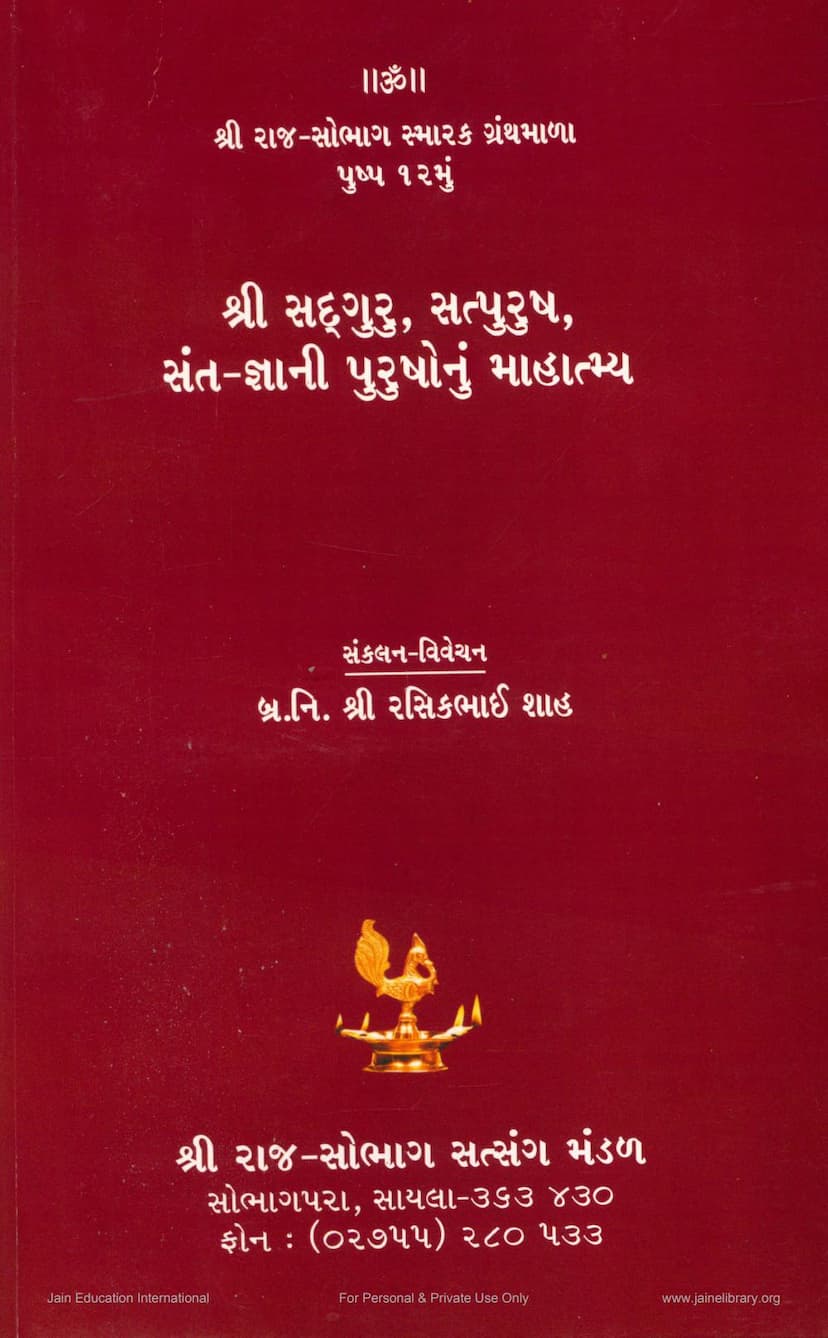Sadguru Satpurush Sant Gyani Purushonu Mahatmya
Added to library: September 2, 2025

Summary
This book, "Shri Sadguru, Satpurush, Sant Gyani Purushonu Mahatmya" (The Greatness of the True Guru, Virtuous Man, Saint, and Knower of Truth), compiled and commented upon by Brahamachari Shri Rasikbhai T. Shah and published by Shri Raj-Saubhag Satsang Mandal Sayla, is a profound exploration of the significance and teachings of spiritual masters within the Jain tradition.
The book draws extensively from the "Vachanamrut" of Shrimad Rajchandra and the handwritten teachings of Param Pujya Sadguru Dev Ladakchand Manekchand Vora. The author's intention is to present these valuable insights to spiritual seekers (mumukshus) for their contemplation and spiritual practice.
Throughout the text, a central theme is the paramount importance of the Sadguru, the virtuous soul, the saint, and the enlightened one in the journey towards spiritual liberation. The book emphasizes that true spiritual knowledge and liberation cannot be attained without the guidance of such masters.
Key themes and teachings explored in the book include:
- The Role of the Sadguru: The book repeatedly stresses that the Sadguru is indispensable for understanding the true nature of the soul and the path to liberation. Their teachings are considered the true means to cross the ocean of worldly existence. The analogy of a boat carrying a stone across water illustrates how the Guru's guidance helps the disciple navigate the spiritual path, whereas self-effort (swachhhand) alone can lead to further wandering.
- The Nature of Problems and Faith: Problems are presented not as obstacles to be avoided, but as tests that reveal and strengthen one's faith. With faith and perseverance, problems can become stepping stones to spiritual progress.
- Overcoming Obstacles: The text provides practical advice on dealing with challenges, emphasizing the need for unwavering faith in the divine, patience, and the importance of not succumbing to negative emotions like envy, hatred, or slander.
- The Importance of Humility and Detachment: Achieving spiritual knowledge requires humility (vinay) and a reduction in attachment and possessions. This fosters inner discernment and opens the path to receiving the Guru's wisdom.
- Understanding the Divine Will: The book highlights the necessity of knowing the true commands of the omniscient beings (Jinas) and their pure form. This knowledge is best acquired from an enlightened Guru.
- Emulating the Virtuous: Understanding the inner essence and conduct of virtuous souls is presented as a direct path to becoming like them and ultimately attaining the state of Godhood.
- The Power of Satsang and Association: Close association with virtuous souls (satsang) is crucial for shedding ignorance and realizing one's true self.
- Inner Vision over External Actions: True spiritual insight comes from observing the inner state of enlightened beings, rather than just their outward actions.
- The Path of Devotion and Discipline: The text advocates for devotion to the Guru, living a disciplined life, controlling desires, and engaging in constant contemplation of sacred texts.
- The Essence of True Knowledge: True knowledge is not just theoretical but experiential, residing within the enlightened person. Their words are a direct reflection of their inner experience.
- Surrendering to the Guru: The book strongly advises surrendering oneself completely to the Guru, dedicating one's mind, body, and wealth to them, and following their guidance with unwavering faith. This surrender is presented as the most effective way to achieve spiritual liberation.
- The Impermanence of Material Possessions: The futility of material wealth and worldly attachments is underscored, as they offer no solace in the face of death and the cycle of rebirth.
- The Significance of Self-Reflection: Continuous introspection, identifying one's own faults, and seeking to rectify them are vital for spiritual growth.
- The Role of Asceticism and Self-Control: The importance of practicing self-control, renouncing worldly desires, and living a life of restraint is repeatedly mentioned as essential for spiritual progress.
- The Transformative Power of the Guru's Grace: The book illustrates how the Guru's grace can purify the soul, dispel ignorance, and guide the disciple towards the path of liberation.
- The Nature of the Enlightened Being: Enlightened beings are described as detached, free from ego, filled with compassion, and living in the present moment, experiencing equanimity in all circumstances.
- The Superiority of Present Gurus: While the teachings of past Tirthankaras are valuable, the book emphasizes that direct guidance from a living, present-day enlightened Guru is paramount for overcoming one's own obstacles and achieving true spiritual realization.
- The Importance of Understanding, Not Just Memorizing Scriptures: Scriptures provide the path, but the true essence (marm) of how to attain liberation lies within the enlightened Guru.
- The Ultimate Goal: Self-Realization: The ultimate aim of spiritual practice is to realize one's true self, the pure, unadulterated soul, and to abide in that state of eternal bliss and liberation.
- The Dangers of Self-Will and Misguided Practice: The book warns against following one's own whims and interpretations of spiritual matters without the guidance of a qualified Guru, as this can lead to further entanglement in the cycle of birth and death.
- The Efficacy of the Guru's Command: Following the Guru's commands, even seemingly simple ones, leads to the eradication of ego and the manifestation of true spiritual qualities.
In essence, "Shri Sadguru, Satpurush, Sant Gyani Purushonu Mahatmya" serves as a comprehensive guide for those seeking spiritual enlightenment, underscoring the central and transformative role of the Guru in the Jain path to liberation. It encourages devotion, discipline, detachment, and unwavering faith in the teachings and guidance of the enlightened masters.